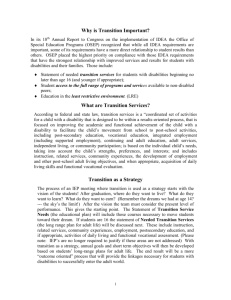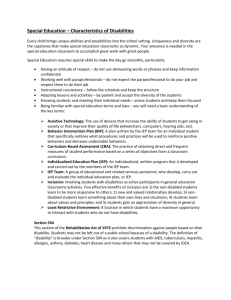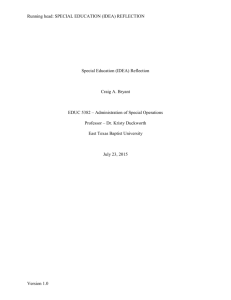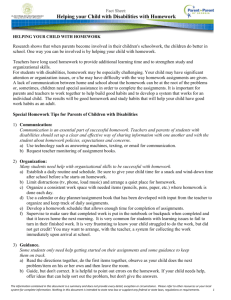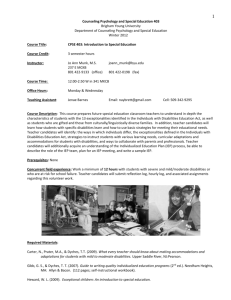Counseling Psychology and Special Education 400
advertisement
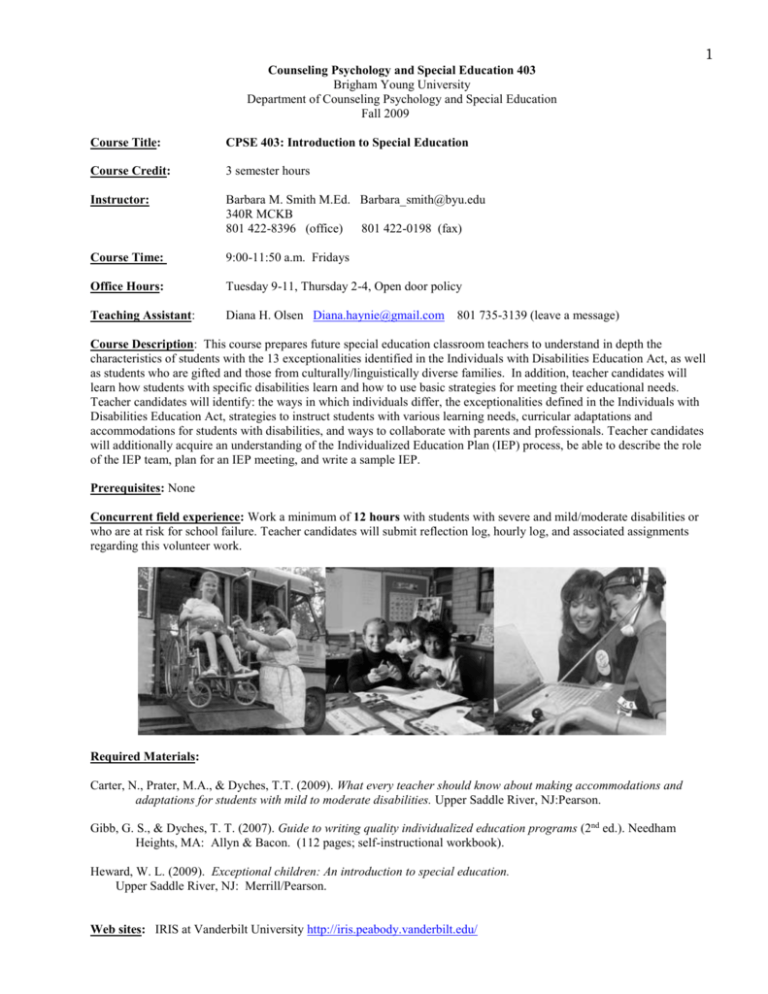
1 Counseling Psychology and Special Education 403 Brigham Young University Department of Counseling Psychology and Special Education Fall 2009 Course Title: CPSE 403: Introduction to Special Education Course Credit: 3 semester hours Instructor: Barbara M. Smith M.Ed. Barbara_smith@byu.edu 340R MCKB 801 422-8396 (office) 801 422-0198 (fax) Course Time: 9:00-11:50 a.m. Fridays Office Hours: Tuesday 9-11, Thursday 2-4, Open door policy Teaching Assistant: Diana H. Olsen Diana.haynie@gmail.com 801 735-3139 (leave a message) Course Description: This course prepares future special education classroom teachers to understand in depth the characteristics of students with the 13 exceptionalities identified in the Individuals with Disabilities Education Act, as well as students who are gifted and those from culturally/linguistically diverse families. In addition, teacher candidates will learn how students with specific disabilities learn and how to use basic strategies for meeting their educational needs. Teacher candidates will identify: the ways in which individuals differ, the exceptionalities defined in the Individuals with Disabilities Education Act, strategies to instruct students with various learning needs, curricular adaptations and accommodations for students with disabilities, and ways to collaborate with parents and professionals. Teacher candidates will additionally acquire an understanding of the Individualized Education Plan (IEP) process, be able to describe the role of the IEP team, plan for an IEP meeting, and write a sample IEP. Prerequisites: None Concurrent field experience: Work a minimum of 12 hours with students with severe and mild/moderate disabilities or who are at risk for school failure. Teacher candidates will submit reflection log, hourly log, and associated assignments regarding this volunteer work. Required Materials: Carter, N., Prater, M.A., & Dyches, T.T. (2009). What every teacher should know about making accommodations and adaptations for students with mild to moderate disabilities. Upper Saddle River, NJ:Pearson. Gibb, G. S., & Dyches, T. T. (2007). Guide to writing quality individualized education programs (2nd ed.). Needham Heights, MA: Allyn & Bacon. (112 pages; self-instructional workbook). Heward, W. L. (2009). Exceptional children: An introduction to special education. Upper Saddle River, NJ: Merrill/Pearson. Web sites: IRIS at Vanderbilt University http://iris.peabody.vanderbilt.edu/ 2 Guiding Framework: As a department, we embrace the Interstate New Teacher Assessment and Support Consortium (INTASC) Standards as our guiding framework for preparing teacher candidates. The Interstate New Teacher Assessment and Support Consortium (INTASC) Standards: The INTASC standards center on five major propositions: (1) Teachers are committed to students and their learning. (2) Teachers know the subjects they teach and how to teach those subjects to diverse learners. (3) Teachers are responsible for managing and monitoring student learning. (4) Teachers think systematically about their practice and learn from experience. (5) Teachers are members of learning communities. Course Objectives Content Covered 1. Describe the ways in which people differ, learning characteristics and special learning needs. 2. Define special education and describe the legal structure of services for individuals with disabilities, including the Individuals with Disabilities Education Act. 3. Articulate issues related to the identification of students with disabilities, referral and placement and the need to provide differing levels of support. INTASC and CEC Standards 3: Diverse Learners CC1K5 CC1K10 CC5K9 CC6K2 CC6K3 CC9K1 7: Planning Instruction CC1K8 CC8K2 GC1K7 Assessment Disability Awareness Final Project Practicum Reflection Log Continuum of Placements Final Project 3. Diverse Learners GC1K1 GC8K2 GC3S1 RTI module 4. Articulate issues related to collaboration in special education. Identify the skills for effective collaboration. 5. Describe policies and programs for young children; define elements of the Child Find system. 10: Collaboration, Ethics, and Relationships Continuum of Placements Final Project 2: Student Development EC1K3 Practicum Reflection Log Final 6. Describe the steps in the Individualized Education Program (IEP) process. 7: Planning Instruction CC3K3 RTI IRIS Module Gibb & Dyches workbook Final 7. Describe the characteristics, prevalence, and educational implications for students with specific learning disabilities, speech or language impairment, mental retardation, and emotional disturbance. 8. Describe the characteristics, prevalence, and educational implications for students with other health impairments, orthopedic impairment, visual impairments, autism, traumatic brain injury, deaf/blindness, and developmental delay. 9. Describe the effects of cultural, ethnic, and language diversity on the education of individuals with disabilities 10. Identify strategies for accommodating to meet individual student needs. 3: Diverse Learners CC1K5 CC1K9 CC2K3 CC10K4 Practicum Reflection Log Disability Awareness Final Project 3: Diverse Learners CC1K5 CC1K9 CC2K3 CC10K4 Practicum Reflection Log Disability Awareness 3: Diverse Learners CC1K5 GC1K7 CC3K5 CC3K4 7: Planning Instruction CC1K9 CC10K4 Practicum Reflection Log Final Project 10. Demonstrate the ability to use assessment results to make instructional decisions. 11. Complete a 12-hour field experience involving volunteer service with four students with disabilities (2 at each site) and submit assignments regarding the experience. 7: Planning Instruction Final Project 3: Diverse Learners CC1K5 CC1K9 CC1K10 CC3K3 CC3K4 CC6K2 CC6K3 CC10K4 GC1K7 Practicum Reflection Log Final Project Tier 2 Intervention Plan Final Project 3 Course Content The figure below illustrates the visual model for the course. In this course, you will learn that you have a responsibility to oversee the referral and evaluation process for students who may qualify for special education services. As a teacher candidate, you will learn how to evaluate the academic/social performance of your students and how to initiate interventions when students are at-risk for failure. You will learn how to make instructional accommodations/adaptations that meet the educational needs of students who are receiving special education services. Throughout the IEP process, you will collaborate with general education teachers and parents to ensure that an appropriate education is provided for students with exceptional learning needs. Receive Special Education Referral Determine Eligibility Teachers Oversee IEP Planning When Necessary Collaborate to Develop Appropriate Instruction with Necessary Accommodations Consistently Monitor and Report Student Progress 4 Learning Outcomes (CPSE 403 – http://learningoutcomes.byu.edu) Collaboration: Candidates work effectively with parents, professionals, paraprofessionals, and others in the school and community to help students with disabilities achieve their IEP goals. Interpersonal Relations: Candidates work with students, parents, professionals, paraprofessionals, and others in the school and community with kindness and respect regardless of their diverse backgrounds. Professional Practice: Candidates fulfill all duties and assignments, comply with all education laws and policies, and continue to improve professional practice. Course Assignments/Assessments Assignments/Assessments Connections Journal Field Experience Assignments o Practicum Reflection Log o Signed Cooperating Teacher Contract o Signed Hour Log o Professionalism Evaluation Course Assignments o Disability Awareness Assignment o IRIS Response-to-Intervention Module o Tier-2 Intervention Plan o Continuum of Placements Assignment o IEP Workbook Assignment Final Project Course Evaluation TOTAL POINTS Point Value 50 (10 @5 points each) 60 points 20 (2 @10 points each) 10 points 10 (2 @5 points each) 10 points 10 points 10 points 40 points 45 points 100 points 5 points 370 Your letter grade for the course will be calculated using the following percentages: A 95 - 100 B+ 87 - 89 C+ 77 - 79 D+ 67 - 69 A- 90 - 94 B 83 - 86 C 73 - 76 D 63 - 66 B- 80 - 82 C- 70 - 72 D - 60 - 62 Course Assignment Summary Field Experience: You will spend 12 hours at two approved sites, six hours at a severe site and six hours at a mild/moderate site. Teacher candidates are encouraged to visit the sites in teams of two. You will create your own schedule and make your own arrangements with the Cooperating Teacher. It is recommended that you plan to attend each site three times for two hours, and that you try to include both a secondary and an elementary site in your schedule. Reading Assignments: Reading materials include: Exceptional Children: an Introduction to Special Education, What Every Teacher Should Know About (WESTKA) Making Accommodations book, and materials posted on blackboard. Connections Journal Assignments: For each assigned chapter, students will complete the Connections Journal assignment (1/2 -1 page reflection on assigned readings). Course Assignments: Students will complete the following assignments. The first four assignments listed below will each be approximately 1-2 pages in length. 1. Disability Awareness Assignment 2. The IRIS Response‐ to‐ Intervention Module and Assessment 3. Tier 2 Intervention Plan (based on behavioral and academic scenario) 4. Continuum of Placements Assignment 5. Gibb and Dyches IEP Workbook 6. Practicum Reflection Log, 2 Cooperating Teacher Contracts, and Cooperating Teacher’s Professional Evaluation 5 Final Project: The final for the course is a collaboration assignment. Students will work with a peer to develop a hypothetical case study. Due Dates: Due dates are indicated on the course schedule. Assignments: Assignments are to be handed at the beginning of class on the due date designated by the instructor. (This applies in the case of absences, also.) Assignments will be lowered 10% for each day late. No assignments will be accepted after the last day of class. Course Evaluation: Complete the course/instructor evaluation found on BYU’s system. Course Expectations • Course Work: Written work is expected to be professionally written. Please proofread all work prior to submission. Assignments should typed and be free from spelling, grammatical, and typographical errors. • Assignments: All written work must reflect the efforts of the individual student unless it is a group assignment. • Time Commitment: University standards are 2 to 3 hours of out-of-class work for each credit hour. For this class you may spend 4 to 6 hours a week completing course work. • Personal Responsibility: Students are expected to check the online course information and/or the course syllabus for clarification regarding assignments prior to contacting the instructor. Students are responsible for completing course work and for managing learning behavior in and out of class. If you encounter problems completing course work, it is your responsibility to contact the instructor to resolve issues. • Classroom Behavior: Reading and sending emails, completing work for other courses while in class, working on puzzles, or any other multi-tasking type activity is not an appropriate use of the learning opportunity available in class. Cell phones should be turned off prior to class. • Professionalism: You are expected to behave in a professional manner. If you have concerns about the course, you should discuss your concerns privately with the instructor. The classroom is not an appropriate forum for airing personal frustration or stress. Success in the Course I hope that all students enrolled in this course will achieve desired outcomes. Successful students in this course attend class, read the lessons, and complete assignments on time. Completing work on time is especially important. Typically, this is a busy semester for students. If you get behind early in the semester, it becomes increasingly difficult to catch up. Turn in work on time—particularly during practicum break. Students should contact me when they encounter problems completing assignments or attending class. I am willing to work with students who proactively manage their learning experience. Methodologies/Teaching Strategies: Course learning includes reading the lessons, completing mastery checks, accessing internet sites, viewing electronic video presentations, and working with a child with special needs, attending class and participating in instructional activities in class. Other Critical Information: Please be courteous to all members of the class by turning off cell phones and beepers during class time. I will be communicating with you via e-mail this term. As a BYU student, each of you has access to an account. Please obtain your account information and inform us of your e-mail address. You are also expected to learn how to use Blackboard to access information for this course. Information will follow. THANK YOU! Grading Grading your performance is a complex process. As your teacher I consider myself a mentor, but as your evaluator I must be as impartial and objective as possible. Your grades reflect both effort and achievement, not effort alone. 6 Honor Code In keeping with the principles of the BYU Honor Code, students are expected to be honest in all of their academic work. Academic honesty means, most fundamentally, that any work you present as your own must in fact be your own work and not that of another. Violations of this principle may result in a failing grade in the course and additional disciplinary action by the university. Students are also expected to adhere to the Dress and Grooming Standards. Adherence demonstrates respect for yourself and others and ensures an effective learning and working environment. It is the university’s expectation, and my own expectation in class, that each student will abide by all Honor Code standards. Please call the Honor Code Office at 422-2847 if you have questions about those standards. Plagiarism Writing submitted for credit at BYU must consist of the student's own ideas presented in sentences and paragraphs of his or her own construction. The work of other writers or speakers may be included when appropriate (as in a research paper or book review), but such material must support the student's own work (not substitute for it) and must be clearly identified by appropriate introduction and punctuation and by footnoting or other standard referencing. The substitution of another person's work for the student's own or the inclusion of another person's work without adequate acknowledgment (whether done intentionally or not) is known as plagiarism. It is a violation of academic, ethical, and legal standards and can result in a failing grade not only for the paper but also for the course in which the paper is written. In extreme cases, it can justify expulsion from the University. Because of the seriousness of the possible consequences, students who wonder if their papers are within these guidelines should visit the Writing Lab or consult a faculty member who specializes in the teaching of writing or who specializes in the subject discussed in the paper. Useful books to consult on the topic include the current Harcourt Brace College Handbook, the APA Handbook, and James D. Lester's Writing Research Papers. Mission Statement of the BYU Special Education Programs: We maximize the potential of diverse learners with individualized educational needs to elevate their quality of life. We accomplish this by supporting the mission and aims of a BYU education as we integrate teaching, research, and service. We specifically: Prepare competent and moral educators who select, implement, and evaluate research-based effective teaching practices and appropriate curriculum for learners with special needs. Prepare master special educators who provide collaborative leadership to foster the moral development and improve learning and social competence of exceptional children with challenging behaviors. Add to the knowledge base of special education and related disciplines through research. Serve and advocate for learners with individualized educational needs and others who support them. Preventing Sexual Harassment Title IX of the Education Amendments of 1972 prohibits sex discrimination against any participant in an educational program or activity that receives federal funds. The act is intended to eliminate sex discrimination in education. Title IX covers discrimination in programs, admissions, activities, and student-to-student sexual harassment. BYU’s policy against sexual harassment extends not only to employees of the university, but to students as well. If you encounter unlawful sexual harassment or gender-based discrimination, please talk to your professor; contact the Equal Employment Office at 4225895 or 367-5689 (24-hours); or contact the Honor Code Office at 422-2847. Students with Disabilities Brigham Young University is committed to providing a working and learning atmosphere that reasonably accommodates qualified persons with disabilities. If you have any disability which may impair your ability to complete this course successfully, please contact the Services for Students with Disabilities Office (422-2767). Reasonable academic accommodations are reviewed for all students who have qualified, documented disabilities. Services are coordinated with the student and instructor by the SSD Office. If you need assistance or if you feel you have been unlawfully discriminated against on the basis of disability, you may seek resolution through established grievance policy and procedures by contacting the Equal Employment Office at 422-5895, D-285. 7 Course Calendar Class Focus 1 Introduction, Syllabus, and Sep. 4 Disability Awareness 2 Sep.11 3 Sep.18 4 Sep.25 5 Oct. 2 6 Oct. 9 7 Oct.16 8 Oct.23 9 Oct.30 10 Nov. 6 11 Nov.13 12 Nov.20 13 Nov.24 14 Dec. 4 Reading(s) C. Journal Course and Field Assignment(s) 1st Cooperating Teacher Contract Overview of Special Ed Law Teacher Responsibility Disability Awareness & Placements; Distinction between 504 and IDEA Pre-Referral Learner Characteristics Heward Ch. 1 & 2 WETSKA Part 1 High Incidence Disabilities: Learning Disabilities and Emotional Disturbance High Incidence Disabilities: Intellectual Disabilities and Communication Disorders Low Incidence Disabilities Visual and Hearing Impairments, Orthopedic Impairment, Traumatic Brain Injury and Other Health Impairments Low Incidence Disabilities Severe and Multiple Disabilities, Autism Early Intervention Other Learning Needs Gifted and Talented, Multicultural Issues, Poverty RTI and PBS Heward Ch. 4 & 5 IEP Process and the IEP Team Overview of Referral Process Writing IEPS PLAAFPS and Goals Goalview Assessment Accommodations for IEPs Planning IEP Meetings Reporting Student Progress Classroom Accommodations: Academic and Social/Behavioral Differentiated Instruction, Classroom Approaches Final Project DUE DATE_____________ Disability Awareness Heward Ch. 6 & 8 Heward Ch. 7, 9, & 10 IRIS Disability Module 1 Visual Disabilities Heward Ch. 11 & 12 2nd Cooperating Teacher Contract 1st CT Professionalism Evaluation Practicum Reflection Journal Heward Ch. 13 & 14 Continuum of Placements IRIS RTI Modules Part 1 & 2 (Heward Ch. 2) Iris Response to Intervention Module and Assessment Gibb & Dyches text IEP Workbook due WETSKA Part 3 Heward Ch. 3 WETSKA Part III IRIS Module— Classroom Assessment (Part 1): An Introduction to Monitoring Academic Achievement in the Classroom WETSKA Part II Tier 2 Intervention Plan Practicum Reflection Journal 2nd CT Professionalism Evaluation Hourly Log of Practicum Attendance Form 8 Bibliography Alberto, P. A. & Troutman, A. (2009). Applied behavior analysis for teachers. Upper Saddle River, NJ: Merrell/Pearson. Anderson, P. L. (1997). Case Studies for Inclusive Schools. Austin, TX: PRO-ED, Inc. Garguilo, R. M. (2009). Special education in contemporary society: An introduction to exceptionality. Los Angeles, CA: Sage Publications. Hardman, M. L., Drew, C. J., &Egan, W. L. (2008). Human exceptionality: School community, and family (9th Ed.), Boston: Houghton Mifflin. Lenz, B. K., Deshler, D. D. (2004). Teaching content to all: Evidence-based inclusive practices in middle and secondary Schools. Boston: Pearson. Mastropieri, M.A., & Scruggs, T.E. (2007). The inclusive classroom: Strategies for effective instruction. Upper Saddle River, NJ: Pearson. Prater, M.A. (2008). Chapter 2: Laws and reform impacting special education from: Teaching strategies for students with mild to moderate disabilities. Boston: Pearson.


